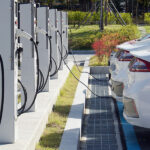Processes in a production facility can be optimized with the aid of indoor localization and route analysis. In addition, an asset tracking solution makes it possible to retrieve location, service life, and movement history of goods.
AT A GLANCE
- real-time localization of vehicles
- calculation of optimal routes
- positioning of goods
- transport process monitoring
PROBLEM DEFINITION
In a warehouse or production facility, thousands of goods have to be processed by vehicles (forklifts, pallet trucks, telescopic forklifts, tugger trains, driverless transport vehicles, prime movers, etc.). The runways aren’t always perfect, there are many empty runs. It also happens that the exact position of vehicles and goods is unknown, that wares are undetectable or not delivered in time. Thus, production might have to be interrupted or extended, which is very expensive.
SOLUTION
The position of the vehicles is detected with an accuracy of 10-30 cm using indoor positioning via Ultra-wideband. The position is displayed on a digital map which is accessible via app and web interface. It should be calculated automatically and in real time if a vehicle will be late. Thus, it is possible to intervene in time. The system also calculates the best runways and can be connected to the merchandise management system (ERP) to make sure all wares are available at any time.
In addition to the localization of the forklift trucks, the individual goods can be tracked using a passive RFID system. Each vehicle can read out an item’s ID from a short distance. The correlation between the identification time of the goods and the position data of the vehicle enables a monitoring of the entire transport chain.
TECHNICAL IMPLEMENTATION
If a very precise localization (10-30 cm) with low latency is desired, server-based indoor positioning with Ultra-wideband (UWB) is the right choice. For this purpose, several infsoft Locator Nodes are installed. The vehicle that should be tracked is equipped with a battery-powered infsoft Locator Tag which measures the distance (Time of Flight, ToF) to the Locator Nodes.
If, in addition to the tracking of the vehicles, a positioning of goods is desired, a Locator Node can be attached to the vehicle instead of a Locator Tag. In this scenario, the Locator Node is not only used as a hardware for indoor positioning via UWB, but also as an RFID reader, which supplies power to RFID tags (which are attached to goods) and then captures the data stored in the microchip of the tag (usually an ID number). If the time of the identification of the RFID tag is associated with the position data of the vehicle, location, service life and the whole transportation process of the goods can be tracked.
The position and, where applicable, identification data collected by the Locator Tag or Locator Node are transmitted to the infsoft LocAware platform® via internet connection. There, the positions of the vehicles are calculated and the data are transferred to an output medium or an ERP system. Significant key figures are e.g. route information (live and historical), number of trips per day/shift, number of hours and kilometers driven per day/shift, as well as maximum, minimum and average driving time and speed.








